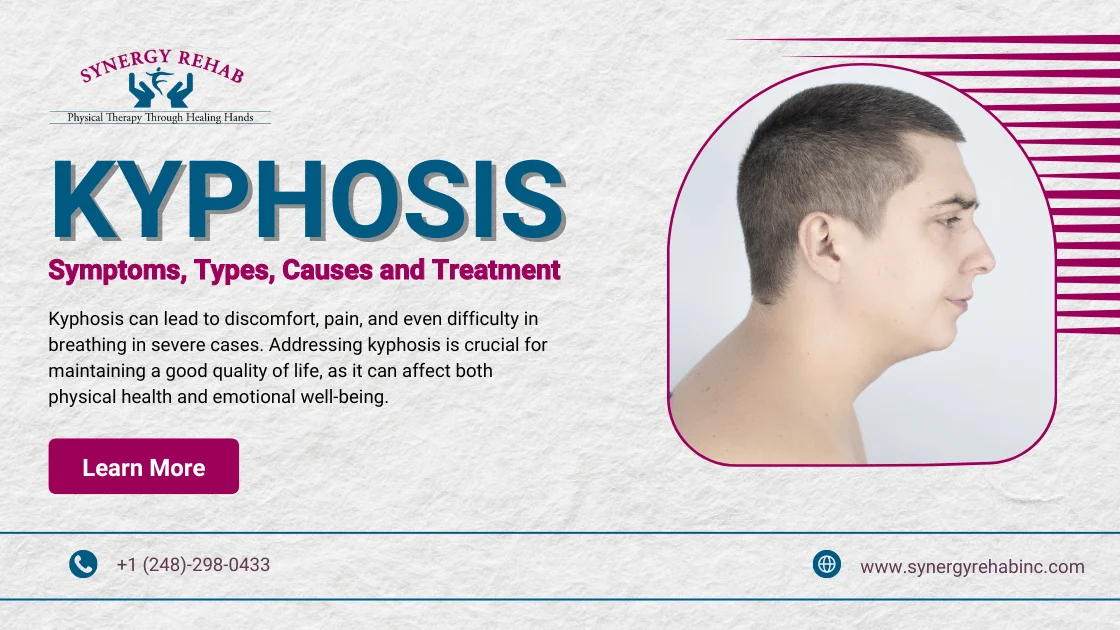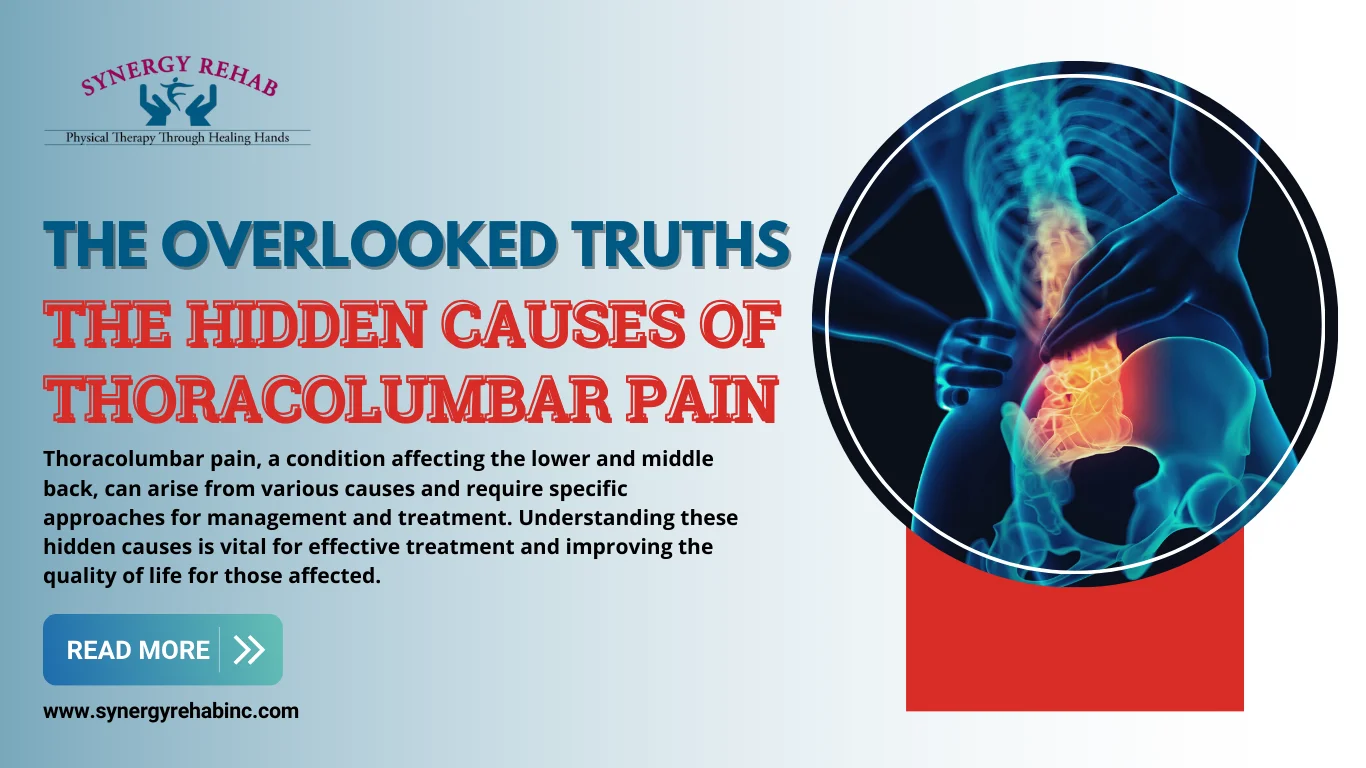
Kyphosis – Symptoms, Types, Causes and Treatment
Kyphosis (pronounced: kye-Foh-sis), commonly known as a “Rounded upper back” or “Hunchback,” is a condition characterized by an excessive outward curvature of the spine. This condition can lead to discomfort, pain, and even difficulty in breathing in severe cases. Addressing kyphosis is crucial for maintaining a good quality of life, as it can affect both physical health and emotional well-being. Physical therapy is one of the best Kyphosis treatment options, and it provides relief to many. Only extremely severe conditions may need surgical intervention. Let us understand the condition, its symptoms, causes and treatment in detail. What Are the Signs & Symptoms of Kyphosis? The main signs & symptoms of kyphosis are: Early Detection and Diagnosis Early detection of kyphosis is essential for effective treatment. Regular check-ups and awareness of these signs can help diagnose kyphosis early. If you notice any of these symptoms, it is important to consult a healthcare provider or Tapan Raut, the best physical therapist in Southfield, MI, for a thorough evaluation and appropriate treatment plan. Book Free Consultation What Are the Types of Kyphosis? Postural Kyphosis: This is usually caused by poor posture, such as slouching or hunching over for long periods. Common in teenagers and young adults, this type features a smooth, flexible curvature that can often be corrected with improved posture and exercises. Symptoms include mild back pain and a noticeable curvature that corrects when lying down.Treatment involves posture correction, stretching, strengthening exercises, and physical therapy. Scheuermann’s Kyphosis: This developmental disorder occurs when the vertebrae grow unevenly, leading to a wedge shape. Typically developing during adolescence, this type has a rigid, angular curve. Symptoms include severe back pain, a prominent hump, and reduced flexibility.Treatment may include physical therapy, back braces, and, in severe cases, surgery to correct the spine. Congenital Kyphosis: Present at birth due to abnormal spinal development during fetal growth; this progressive curvature worsens as the child grows, often leading to severe deformities. Symptoms are noticeable early in life and worsen over time. What are the Causes of Kyphosis? Poor Posture: Poor posture, such as slouching, hunching over desks, and prolonged use of electronic devices, is a common cause of kyphosis, especially postural kyphosis. This type is often seen in teenagers and young adults and results from habits that lead to an abnormal curvature of the spine. Degenerative Diseases: Age-related degenerative diseases, such as arthritis and degenerative disc disease, cause the deterioration of spinal discs and joints. Osteoporosis, which weakens the bones, can cause vertebrae to collapse, leading to abnormal spine curvature and kyphosis, particularly in older adults. Spinal Fractures: Trauma to the spine, including fractures from accidents or injuries, can result in kyphosis. When multiple vertebrae are damaged, the spine may heal with an abnormal curvature. Osteoporotic fractures are especially common in older adults and contribute significantly to the development of kyphosis. Congenital Factors: Congenital kyphosis occurs due to malformations in the spine that develop before birth. These abnormalities in vertebral formation can lead to progressive curvature as the child grows. This type of kyphosis often requires surgical intervention to correct the spine and prevent further complications. Other Medical Conditions: Several medical conditions can also lead to kyphosis. Spinal infections, such as tuberculosis, can damage vertebrae and cause curvature. Neuromuscular conditions, like muscular dystrophy, weaken the spinal muscles, leading to abnormal spine curvature.Additionally, nutritional deficiencies, particularly a lack of Vitamin D, can weaken bones and contribute to kyphosis. How is Kyphosis Diagnosed? Physical Examination: The physician will check the patient’s posture and spinal alignment. The patient may be asked to bend forward and sideways to assess the spine’s flexibility and curvature. X-rays and MRI: X-rays are the primary tool for diagnosing kyphosis, providing detailed images to measure spinal curvature and identify abnormalities. If more detailed information is needed, an MRI scan may be needed to examine the spinal cord thoroughly, as well as the nerves or soft tissues. How is Kyphosis Treated? There are two major ways to treat kyphosis: Physical Therapy: Customized stretches and workouts help reduce discomfort, strengthen back muscles, and enhance posture. When treating mild to severe kyphosis, physical therapy is frequently the primary course of action for back pain treatment. Bracing: Wearing a back brace can help children and adolescents with Scheuermann’s kyphosis avoid developing additional curvature as they grow. Usually, bracing is advised for people whose bones are still growing. Can Kyphosis Turn Into Scoliosis? No. Your spine can be affected by both scoliosis and kyphosis. Although they might occur simultaneously, one does not trigger the other. The abnormal spine bending from front to back is known as kyphosis. The abnormal curvature of the spine, either horizontally or from left to right, is known as scoliosis. Why Doctors Recommend Physical Therapy for Kyphosis Treatment Physical therapy is a highly effective and non-invasive treatment option for kyphosis. Here are several reasons why it is a preferred choice: Improves Posture: Physical therapy focuses on correcting poor posture, a common cause of postural kyphosis. Through targeted exercises and stretches, physical therapists help patients develop better posture habits, which can significantly reduce spinal curvature. Reduces Pain: Therapeutic exercises and manual therapy techniques used in physical therapy can effectively relieve back pain and muscle tension associated with kyphosis. This leads to an improved quality of life and better overall function. Customized Treatment Plans: Physical therapists create individualized treatment plans tailored to each patient’s specific needs and conditions. This personalized approach ensures that the exercises and therapies are suitable and effective for the patient’s particular type of kyphosis and overall health. Visit Synergy Rehab Physical Therapy for Kyphosis Treatment If you’re struggling with kyphosis, Synergy Rehab offers comprehensive kyphosis treatment options to help you manage and improve your condition. Our expert team provides personalized care, utilizing the latest back pain physical therapy techniques to address your specific needs. Take the first step towards better spinal health and improved quality of life. Book a consultation with Synergy Rehab today and start your journey to a healthier spine.

5 Mental and Physical Wellbeing Tips for 2024 from Best Physical Therapist in Southfield
While serving as a physical therapist in Southfield, I’ve seen firsthand the importance of maintaining both mental and physical well-being. The year 2024 presents new challenges and opportunities in this realm, and I’m excited to share five key tips to help you stay at your best while undergoing physical therapy. Remember, as Joseph Pilates once said, “Physical fitness is the first requisite of happiness.” Let’s dive into mental and physical fitness! 1. Mindful Movement: Integrating Mind and Body Physical therapy isn’t just about healing; it’s about holistic well-being. A study published in the Journal of Physical Therapy Science emphasizes the benefits of integrating mindful practices like yoga or Tai Chi into your routine. These disciplines help in managing physical therapy for back pain and neck pain, not only by strengthening and stretching the body but also by bringing a sense of mental calm and focus. Incorporating these practices can aid in improving body awareness and reducing stress. Also, Yoga is the best mental health therapy. Tip: Dedicate a few minutes each day to mindful movement. Even just 10 minutes can make a difference. Why It Works: According to a study published in JAMA Internal Medicine, mindfulness and meditation can help ease psychological stresses like anxiety, depression, and pain. Quote to Remember: “The thing about meditation is: You become more and more you.” – David Lynch 2. Regular Physical Activity Along with Physical Therapy: The Backbone of Wellness Consistent physical activity is crucial. It’s not just about intense workouts; even moderate activities like walking or swimming can make a huge difference. The American Heart Association suggests at least 150 minutes per week of moderate-intensity aerobic activity for overall cardiovascular health. Regular exercise helps in managing back and neck pain by strengthening the muscles that support these areas, thereby reducing strain and discomfort. Tip: Engage in physical activities that you enjoy. It could be anything from brisk walking to swimming or even dance classes. Why It Works: Physical activity is not just about physical therapy for back pain or neck pain. It’s a proven stress reliever and mood booster. The American Heart Association recommends at least 150 minutes of moderate-intensity aerobic activity each week for adults. Quote to Remember: “Movement is a medicine for creating change in a person’s physical, emotional, and mental states.” – Carol Welch 3. Ergonomic Adjustments: Your Workspace Matters With many of us spending hours at our desks, ergonomic adjustments are more important than ever. A research article from Applied Ergonomics highlights how proper ergonomic setups can significantly reduce the risk of neck and back pain. Consider a standing desk or an ergonomic chair, and ensure your computer screen is at eye level to avoid slouching. Tip: Regularly adjust your sitting position. Changing your posture throughout the day can help prevent muscle stiffness and fatigue and improve physical fitness. For instance, alternate between sitting and standing if you have an adjustable desk. Why It Works: Ergonomic adjustments work by aligning your body in a natural position that reduces stress on your spine, muscles, and joints. When your workspace is set up correctly, it minimizes the unnatural strain on your body, which is a common cause of workplace-related musculoskeletal disorders. Quote to Remember: “Design is not just what it looks like and feels like. Design is how it works.” – Steve Jobs. 4. Balanced Nutrition: Fuelling Your Body and Mind Nutrition plays a pivotal role in physical and mental health and wellness. As Hippocrates said, “Let food be thy medicine and medicine be thy food.” A balanced diet rich in anti-inflammatory foods can help in managing pain and promote overall health. Incorporating omega-3 fatty acids, found in fish and flaxseeds, and antioxidants, found in fruits and vegetables, can be particularly beneficial for those dealing with chronic pain. Tip: Hydration is key to physical fitness. Drinking enough water throughout the day aids in digestion, absorption of nutrients, and elimination of waste. Staying hydrated can also help in reducing pain flare-ups and improving cognitive function. Why It Works: A diet rich in anti-inflammatory foods and sufficient hydration works by reducing inflammation in the body. Chronic inflammation is often linked to a host of health issues, including chronic pain. Foods rich in omega-3 fatty acids and antioxidants help to combat this inflammation, while proper hydration ensures that nutrients are efficiently transported throughout the body and waste products are removed. Quote to Remember: “You are what you eat, so don’t be fast, cheap, easy, or fake.” 5. Quality Rest and Sleep: The Foundation of Recovery Never underestimate the power of good sleep. The National Sleep Foundation outlines that adults need 7-9 hours of sleep per night for optimal health. Quality sleep is essential for the body’s healing and recovery processes, especially when undergoing physical therapy. It’s during sleep that the body repairs muscle tissue and restores energy levels. Tip: Create a restful environment. Ensure your bedroom is conducive to sleep — cool, dark, and quiet. Consider using blackout curtains, eye shades, earplugs, or “white noise” machines to block out disturbances. Why It Works: Quality sleep works as a restorative process for both the mind and body. It helps consolidate memories and allows the brain to ‘clean house’. Physically, during the deeper stages of sleep, the body releases hormones that stimulate tissue growth and repair blood vessels, aiding in the recovery of muscles, reducing inflammation and improving overall physical health. Quote to Remember: “Sleep is the best meditation.” – Dalai Lama. Let’s Focus on 2024 for Better Mental and Physical Well Being In 2024, let’s focus on these holistic approaches to wellbeing. As your dedicated physical therapist in Southfield, my goal is to guide you through a journey that not only addresses specific pain points like back or neck pain but also enhances your overall quality of life. Remember, wellness is a journey, not a destination. Let’s make this year your healthiest yet!For those seeking specialized guidance, especially in areas like physical therapy for neck pain or back pain, don’t hesitate to reach




